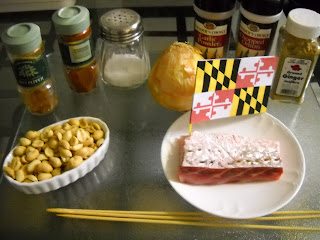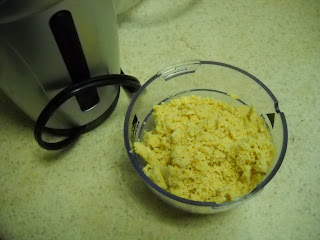 Official Name: State of Maryland
Official Name: State of MarylandState Nicknames: The Free State; The Old Line State; America in Miniature
Admission to the US: April 28, 1788 (#7)
Capital: Annapolis (24th largest city)
Other Important Cities: Baltimore (largest); Columbia (2nd largest); Germantown (3rd largest); Frederick (8th largest)
Region: Mid-Atlantic, South, Northeast; South Atlantic (US Census)
RAFT Nations: Crabcake; Clambake; Chestnut; Maple Syrup
Bordered by: The Mason-Dixon Line (north and east); Pennsylvania (north); Delaware and the Atlantic Ocean (east), Virginia and the Potomac River (south and southwest); District of Columbia (southwest); West Virginia (west and southwest)
Official State Foods and Edible Things: blue crab (crustacean); rockfish, aka striped bass (fish); Diamondback terrapin (reptile); Smith Island cake (dessert); milk (drink)
Some Famous & Typical Foods: Chesapeake Bay foods, especially based on blue crab, oyster, clam, shrimp & fish; historically, foods of the Upper South (especially fried chicken, stuffed ham, beaten biscuits & Brunswick stew); cuisines that reflect a broad multicultural landscape closer to Baltimore (Italian, Polish, Ukranian, German, etc) and Washington (Latin American, West African, Southeast Asian, Korean, etc)
Take Nigeria for example: Maryland has the largest Nigerian-American immigrant population of any state in the country, not to mention recent immigrants from all over West Africa, bringing their varied culinary traditions to the American landscape. Sadly, few West African immigrants have opened up restaurants in the area, though a few do exist - mostly in Prince George's and Montgomery Counties with a small handful in the Baltimore area. Immigrants from Ghana, Mali, Senegal, Liberia and (again) Nigeria are integrating their dishes into the American landscape, but again the lack of restaurants means that if you aren't lucky enough to know someone from Nigeria, you may have to make your own.
One of the most common pan-West African dishes is jollof rice, a dish that, like the crab cake and fried chicken, has many local variants. According to Ghanaian-born Dorinda Hafner, author of A Taste of Africa, jollof rice likely originated in Mali. Or Ghana. Or Nigeria. Well, okay, it hasn't quite been settled, and probably never will.
Jollof Rice is among the best known of West African dishes not only because it is delicious and easy to prepare, but because the ingredients are readily available in Western countries! Its origin, however, remains a bone of contention between several West African nations. There are many regional cooking variations... [Hafner 1993: 43]Regardless of where it originated, most people who eat jollof rice are probably in Nigeria, the largest country in West Africa. Another Nigerian dish that goes well with it is a simple take on the shish kebab, known as suya. This is meat or fish coated in spicy ground peanuts, skewered and broiled or grilled until done. I had this a few years ago at the FestAfrica in Patterson Park, made out of chicken. But I thought a more Chesapeake-flavored version of suya would fit this post better: rockfish.
The recipes: Jollof Rice with Rockfish Suya
You could make the suya while the rice is cooking, if you really like multitasking.
The recipe: Jollof Rice
I could have used chicken, beef or fish - Hafner's version is good, as is this one from the Congo Cookbook. But I wanted something simple and vegetarian, and I settled on a recipe submitted to Sara Moulton's show Sara's Secrets by Simbo Fowora. No, Fowora is not a trained Food Network personality, or a trained chef like Sara Moulton, but the recipe was featured on the show, and I trust Moulton's judgment.
For this vegetarian jollof rice you will need the following, all of which are simple to track down.
* white rice (not difficult to track down)
* tomato paste (I also added cherry tomatoes from the garden - I picked them that same day)
* chili peppers (one from the garden, one from Wegman's)
* bell pepper (Fowora's recipe says to use a red bell pepper - I used a green one)
* a few cloves of garlic
* onions (again, mine from the garden - mine were red, which is not typical of jollof rice)
* thyme and white pepper
* olive oil
First, throw all ingredients except the oil (and the rice, of course) into a blender
.
After blending, add the olive oil, and blend a little bit more.
As you do this, boil a few cups of water on the stove. When boiling, add both your rice and your tomato mixture to the pot.
Cook for about 45 minutes, stirring every fifteen minutes. I actually found the rice to be undercooked, so I added a cup or two more and let it steam with the heat off for another 15 to 20 minutes, stirring occasionally.
Garnish with parsley or cilantro if you have it available. I ate mine with the suya.
The recipe: Rockfish Suya
The recipe I used comes from the Congo Cookbook, which you can find online. Of course, it does not specify rockfish, but it was an easy substitution.
This recipe is also pretty simple:
 * rockfish, or whatever fish or meat you prefer (A note on rockfish, aka striped bass: this is the state fish, so it holds a special place in Maryland's seafood pantheon. I remember when I was much younger and the ban on fishing for rockfish had been lifted, since they were no longer endangered. Dad and Mom went out and bought one and we had rockfish that night. Very nice. Rockfish is pricey - $20 per pound at Wegman's - so I bought a mere quarter pound, just enough to make one serving for dinner)
* rockfish, or whatever fish or meat you prefer (A note on rockfish, aka striped bass: this is the state fish, so it holds a special place in Maryland's seafood pantheon. I remember when I was much younger and the ban on fishing for rockfish had been lifted, since they were no longer endangered. Dad and Mom went out and bought one and we had rockfish that night. Very nice. Rockfish is pricey - $20 per pound at Wegman's - so I bought a mere quarter pound, just enough to make one serving for dinner)* roasted/salted peanuts (you will grind these up but don't make peanut butter with them)
* cayenne pepper, paprika (in this case I used smoked paprika) and salt
* garlic powder, onion powder and ginger powder (since I only had chopped dried onion, I threw that into the spice grinder)
* onion and tomatoes (optional, if you want to skewer them)
* skewers (you really do need these)
Take your peanuts and grind them into a powder. Again, make sure you don't make peanut butter with them. Mix with the dry spices in a bowl, separate into two portions (one for coating and one for dipping later) and set aside.
After cutting your rockfish into pieces, coat them in the peanut mixture. Let them sit for half an hour - enough time to soak the skewers and preheat the broiler.
When ready, stick the rockfish onto the skewers, alternating if you want with onion and/or tomato.
Place the skewers in a dish and put them under your broiler, about 3 to 4 inches below the fire, for 4 to 8 minutes. Other meats or fishes may take longer or shorter to broil. Or you can just grill them.
And there you have your suya! Serve with any extra peanut mixture that did not come into contact with raw meat or fish.
Jollof rice is similar to jambalaya in that it cooks in a variety of spices (and sometimes meats) on the stove for a while, and is a meal unto itself. The similarities end there, because this spicy, tomato-y rice dish is tangy more than anything else. Again, it is very simple to prepare, and I may need to make this again. It is a very nice accompaniment to the suya, whose peanut mixture would make an excellent coating for any broiled or grilled meat or fish. Also, the ease of preparation makes this a recipe to come back to.
Sources:
"Crab Cakes". Recipe from the author's family.
Fowora, Simbo. "Jollof Rice". Featured on the episode "Nigerian Dinner" of the show Sara's Secrets (Sara Moulton, host). Food Network, 2006.
Gibbon, Ed. The Congo Cookbook. 1999-2009. Available as a downloadable book from lulu.com and reprinted on the website http://www.congocookbook.com.
Hafner, Dorinda. A Taste of Africa. Ten Speed Press: Berkeley, CA, 1993.
Kitching, Frances. "Smith Island Ten-Layer Cake-Mrs. Kitching's Original Recipe". Reprinted on the "Fun Stuff" page at the website VisitSomerset.com (website for Somerset County, Maryland). 2007-2010 Somerset County Tourism.
Shields, John. Chesapeake Bay Cooking. Broadway Books: New York, NY, 1998
Shields, John. "Foreward". In Dishing Up Maryland by Lucie Snodgrass. Storey Publishing: North Adams, MA, 2010.
Snodgrass, Lucie. Dishing Up Maryland. Storey Publishing: North Adams, MA, 2010.
Walter, Eugene. American Cooking: Southern Style. From the series Foods of the World. Time-Life Publications: New York, NY, 1971
Some information also obtained from Wikipedia's "Maryland" page and other pages, and the Food Timeline State Foods link to "Maryland".




















0 comments:
Post a Comment